The global myeloproliferative disorders drug market is anticipated to grow significantly during the forecast period due to the increasing prevalence of the various myeloproliferative disorders, the presence of strong pipeline products, frequent product approvals, and growing R&D investments on the development of novel drugs for MPD Treatment market.
According to the National Organization for Rare Disorders (NORD), men are more likely affected than women with Polycythemia vera. The disorder is anticipated to affect around two people per 100,000 in the general population. It occurs most often in individuals over 60 years old but can affect individuals of any age.
However, side effects associated with chemotherapy medications might hamper the growth of the market studied.
Key Market Trends
Myelofibrosis Segment Holds Significant Share in the MPD Treatment Market
Myelofibrosis is a group of rare cancers of bone marrow in which the marrow is replaced by scar tissue and cannot make healthy blood cells. It is classified as a type of chronic leukemia and belongs to a group of blood disorders called myeloproliferative diseases. It is also called as primary myelofibrosis, chronic idiopathic myelofibrosis or myelosclerosis with myeloid metaplasia.
According to the National Organization for Rare Disorders (NORD), the true incidence of MF is not known but estimated to be approximately 1-1.5 per 100,000 people and is likely higher due to under-diagnosing and under-reporting.
Frequent product launches of the drugs for myelofibrosis treatment are expected to drive the segment in the market studied. For instance, in September 2019, Sierra Oncology Inc. received U.S. Food and Drug Administration (FDA) Fast Track designation approval to its momelotinib, a JAK1, JAK2 and ACVR1 inhibitor for the treatment of patients with intermediate/high-risk myelofibrosis who have previously received a JAK inhibitor.
North America Dominates the Global Myeloproliferative Disorders Treatment Market
North America dominates the global MPD treatment market owing to the increase in the prevalence of myelodysplastic syndrome, early adoption of the novel treatments, high R&D investments on the development of the novel drugs, and the presence of sophisticated healthcare infrastructure.
For instance, in August 2019, Celgene Corporation (Acquired by Bristol-Myers Squibb) received U.S. Food and Drug Administration (FDA) approval to its INREBIC (fedratinib) for the treatment of adult patients with intermediate-2 or high-risk primary or secondary (post-polycythemia vera or post-essential thrombocythemia) myelofibrosis.
The Asia Pacific is expected to experience lucrative growth in the global myeloproliferative disorders treatment market due to the developing healthcare infrastructure, rapidly improving economic conditions, and promising regulatory environment for new treatment.
Competitive Landscape
In the market studied, major players are focused on expanding their business in different areas by adopting various market strategies such as partnerships, collaborations, acquisitions, and mergers. Key developments in the market include - in January 2019, Takeda Pharmaceutical Company Limited completed the acquisition of Shire Plc, one of the major players in the event of novel drugs for the treatment of myeloproliferative disorders.
Additional Benefits:
- The market estimate (ME) sheet in Excel format
- 3 months of analyst support
This product will be delivered within 2 business days.
Table of Contents
Companies Mentioned (Partial List)
A selection of companies mentioned in this report includes, but is not limited to:
- AbbVie
- Bristol-Myers Squibb
- Incyte Corporation
- Mylan NV
- Novartis AG
- Pfizer
- Teva Pharmaceuticals
- Takeda Pharmaceutical Company Limited
Methodology

LOADING...








